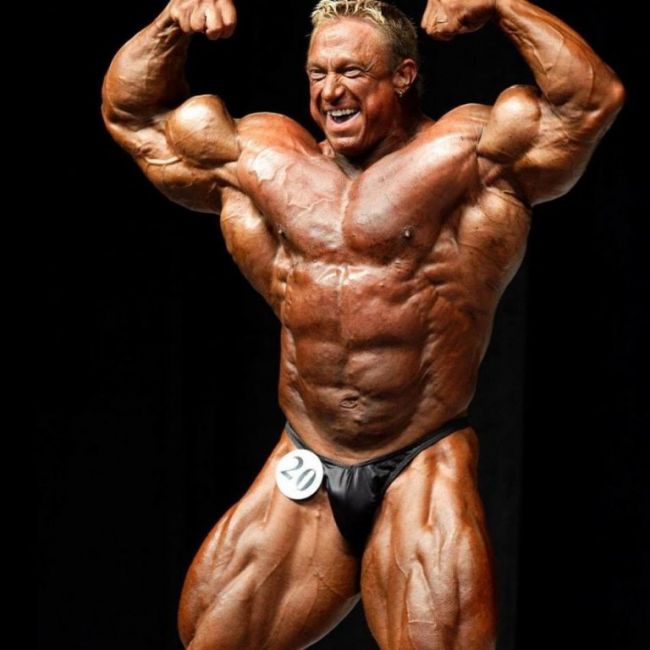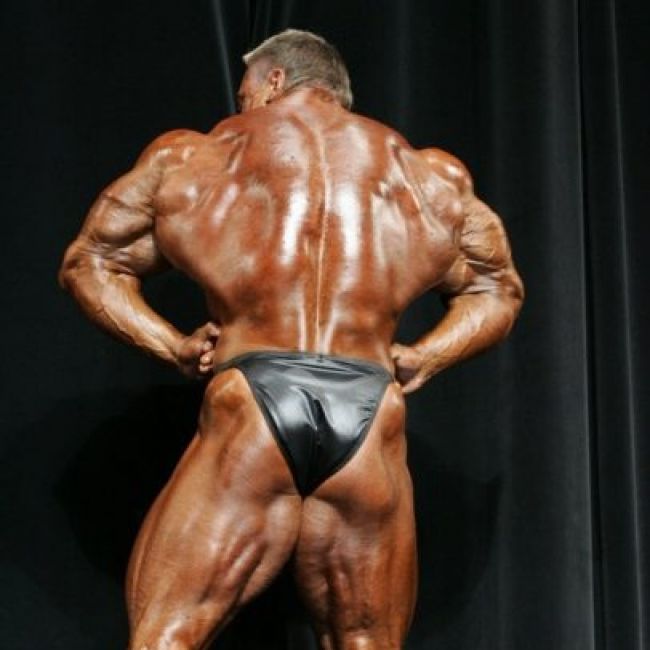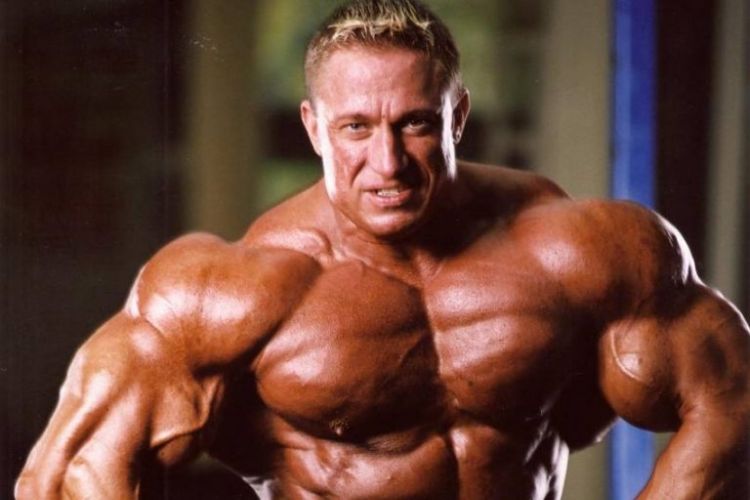A professional bodybuilder from Germany named Markus Ruhl once had one of the most impressive sets of shoulders ever seen in the sport.
Markus Ruhl, however, had no intention of turning into a bodybuilder at first.
Markus played elite soccer for his team in Germany throughout his childhood and puberty. With his performances, he hoped to advance to the professional level of the sport.
But then Markus suffered a serious knee injury, casting doubt on his ability to play soccer in the future. Markus started working out in the gym to help him recover.
Markus decided to pursue bodybuilding instead of soccer as soon as he noticed the changes in his physique as a result of weightlifting.
Since that time, Markus has developed into a renowned professional bodybuilder with a long list of achievements.
It goes like this:
My knee suffered complete damage. The doctor advised me to visit the gym to rebuild a little bit more muscle, so I spent a few weeks in the hospital after that. I went to the gym for that reason.

Body Measurements of Markus Ruhl
| Full Name: | Markus Ruhl |
| HEIGHT: | 275 – 285lbs (124.7kg – 129.3kg) |
| WEIGHT: | 5’10” (177.5cm) |
| NATIONALITY: | German |
| PROFESSION: | Professional Bodybuilder |
| ERA: | 1990, 2000, 2010 |
The fact that simple and compound exercises are the most effective is the most significant lesson I have learned.
Accomplishments
Competition Record Of Markus Ruhl
2010
- IFBB Europa Super Show – 7th place
2009
- Mr. Olympia – 15th place
- New York Pro – 3rd place
2006
- IFBB Austria Pro Grand Prix – 3rd place
- Mr. Olympia – 8th place
2005
- Mr. Olympia – 15th place
2004
- Mr. Olympia – 5th place
2003
- Arnold Classic – 3rd place
2002
- Mr. Olympia – 8th place
- Night of Champions – 1st place
- Toronto Pro Classic – 2nd place
2001
- Mr. Olympia – 14th place
2000
- Mr. Olympia – 7th place
- Joe Weider’s World Pro Cup – 5th place
- Grand Prix England – 5th place
- Night of Champions – 2nd place
- Toronto Pro – 1st place
1999
- Grand Prix England – 7th place
- Joe Weider’s Pro World – 7th place
- Night of Champions – 4th place
- Mr. Olympia – Disqualified
1997
- Hessen Bodybuilding Championships, Overall – 1st place
- German Heavyweight Championships (113kg) – 1st place, Pro Card Earned
1995
- Bachgau Cup (Babenhausen), Heavyweight Class and Overall – 1st place
- Hesse Grand Prix – 2nd place
Movie Appearances
- XXXL-Big Beyond Belief (2000)
- Made in Germany (2004)
- Big and Loving It (2007)
- Ruhling 4 Ever (2010)
“I do this to get big muscles, not to be healthy.”
Biography
Bodybuilding and soccer both
Born on February 22, 1972, Markus Ruhl was raised in Darmstadt, Germany.
Markus was very interested in soccer when he was a teenager. Before an accident, he had years of experience playing the sport.
Markus suffered a severe knee injury that required him to spend a lot of time away from the soccer field.
Markus’ doctor introduced him to bodybuilding while he was waiting to get better and rejoin his soccer team. Markus should train with light weights, according to the doctor, to hasten the healing of his knee.
Markus started working out six days a week at 120 pounds to get back to normal as soon as possible.
Markus, on the other hand, grew fascinated with the changes he noticed in his body throughout the healing process. He decided to give up soccer in favor of bodybuilding as a result.
Growth and Bodybuilding Contests
Markus started working out in the gym when he was 18 years old with the serious goal of growing as much as he could.
He claims, “I quickly discovered my passion for bodybuilding and increased from the initial 63kg to well over 100kg.”
Markus became aware that he was capable of much more than just working out at the gym after noticing the dramatic changes to his physique. He consequently started researching bodybuilding competitions.
The 1994 Hessen Newcomer Championships were supposed to be Markus’ debut bodybuilding event.
Markus had to postpone his bodybuilding competition debut due to an unfortunate injury that he sustained just a few weeks before the show.
Markus finally took the stage a few months later. The competition was called Bachau Cup in Babenhausen. Surprisingly, Markus won first place in both his heavyweight division and the overall competition.
From local to global recognition
Winning his first competition was a huge “boost” for Markus, who was now more inspired than ever to keep working hard and competing.
One week after the Bachau Cup, he increased the stakes by competing in the Grand Prix in Hesse, where he came in second.
After that, Markus continued to take part in bodybuilding competitions. From a national-level competitor to a well-known bodybuilder over the years, he steadily moved up the competitive ladder.
When Markus received his Pro Card in 1999, he had already competed on the biggest bodybuilding stages. Mr. Olympia, Night of Champions, and Joe Weider’s Pro World are a few examples.
Prime Years
Markus’ bodybuilding career was in full swing between the years 2000 and 2006.
He had the opportunity to interact with some of the biggest names in bodybuilding during this time. Jay Cutler and Ronnie Coleman are two examples.
The key accomplishments for Markus during this time include;
- 2000 Toronto Pro, 1st place
- 2000 Mr. Olympia, 7th place
- 2002 Night of Champions, 1st place
- 2004 Mr. Olympia, 5th place
- 2006 Austria Pro Grand Prix, Top 3
Markus was feared at his height for his magnificent shoulders. Markus is still regarded as the bodybuilder who possessed some of the largest delts in bodybuilding history.
You really can’t have both the ability to move heavy objects and strike the perfect pose for the camera.
Training

Training Fundamentals
- Pump – Markus’ primary goal in each workout is to achieve the maximum pump possible. He says the pump determines how he trains that day. If he doesn’t get a good pump using his usual heavyweights, he’ll lower the weight and do more reps. If this doesn’t work, he’ll go even heavier to see if a lower number of reps would yield a better result.
- Full Range of Motion – This links back to the pump. As Markus says, by doing a partial range of motion, he’ll get a partial pump. Likewise, a full range of motion gives him the maximum pump.
- Instinct – Markus never commits himself to a fixed workout plan. Instead, he listens to his body’s signals to determine which workout would be the best at any given moment.
- Heavy Weights – More often than not, Markus gets the best pump by lifting heavy weights with a low number of reps; 1-2. On an odd occasion when he doesn’t get the pump this way, he’ll lower the weight, and increase the number of reps.
- Control the Movement – Markus makes every single repetition count. This way, he places the highest possible stress on the trained muscle.
- Focus – There is no time for talking or playing around when Markus works out. As he says; “During my workout, I’m all business.”
- Learn and Think – Markus never settles in terms of his knowledge of training and dieting. He keeps studying new articles and scientific research to stay on top of his progress in the gym.
.The Shoulder Exercise Guidelines of Markus Ruhl
At his best, Markus worked out with weights six days a week, skipping just one workout. He had a day just for his shoulders, which were his favorite body part.
Markus tried to combine high volume with heavy weights in his shoulder exercises.
Additionally, he worked hard to achieve the best pump and to penetrate “deep” into the tissue of his shoulders during each workout.
These are the guidelines Markus followed to develop his enormous shoulders:
- Go for the maximum pump.
- Aim for moderate-high volume, try to have as many sets and reps on different exercises to hit all three deltoid heads from every angle.
- After the warm-up, push every set to failure.
- Begin every shoulder session with a heavy press like a shoulder press. This helps with achieving the pump right from the beginning.
- Use heavy weights, but also watch out for the form – strict technique and slow movements to maximize results and avoid injuries.
- Hold a 2-3 second squeeze at the peak of the movement to maximize results.
- Take longer rest between sets (~2 minutes) to get the shoulders ready for heavy and intense sets.
- Change the workout up every 2-3 months to ‘surprise’ the muscle and avoid stagnation.
Routine Shoulder
Every few months, Markus changed the way he worked his shoulders. In light of that, here is one of his variations;
- Dumbell shoulder press – warm-up of 30 reps, then, 6 heavy sets of 16-4 reps
- Alternating front dumbbell raises- 4 sets of 12-8 reps
- Upright rows – 3 sets of 10-8 reps
- Standing lateral raise – 5 sets of 15-12 reps
- Bent-over lateral raise – 4 sets of 12-8 reps
- Dumbell shrugs – 5 sets of 12-6 reps
Markus would decrease the number of reps with each subsequent set while increasing the weight.
Workout for the biceps
Markus uses a similar combination of heavy-weight compound lifts and light-to-moderate weight isolation exercises when working his biceps as he would any other body part.
He begins his workout by performing a free-weight exercise to get the most “burn” in his muscles.
Immediately after, he moves on to the exercise that isolates the same muscle (e.g. Standing Dumbbell Curls followed by Seated Machine Curls).
Like always, Markus watches his form carefully when working his biceps. He does not simply raise and lower the weights. He instead moves the weight slowly, being careful to contract the muscle at the peak of the motion.
- Barbell Curls, 6 sets of 4-30 reps
- Seated Barbell Curls, 4 sets of 6-30 reps
- Dumbbell Curls, 6 sets of 6-20 reps
- Preacher Curls, 4 sets of 4-20 reps
- Cable Curls, 4 sets of 4-20 reps
Split Full Body Workout
Here is just one of many variations of Markus’ total-body exercise routine;
- Monday: Chest
- Tuesday: Back
- Wednesday: Triceps
- Thursday: Biceps
- Friday: Legs
- Saturday: Shoulders
- Sunday: Off
Top Exercise For Each Body Part
- Chest – Wide-Grip Bench Press
- Back – Front Wide-Grip Pulldowns
- Biceps – Rühl Curls, Concentration Curls
- Triceps – Close-Grip Bench Press
- Shoulders – Smith Machine Military Press, Bent Dumbbell Lateral Raises
- Quads – Leg Press, Hack Squats
- Hamstrings – Lying Leg Curls
- Calves – Standing Calf Raises
Setting Traps and Using Delts
Markus exercises his trapezius with his deltoids rather than the way some people prefer to train their back.
He explains, “Some people work their traps with their back, but I prefer to hit mine after delts.”
Barbell shrugs are his preferred exercise for building big, strong traps. Markus describes how he prefers to perform the exercise in the following way: “With barbell shrugs, you pull your shoulders up but also slightly back.
Since you can only pull your shoulders straight up, I prefer machine and dumbbell shrugs. There is no motion wasted. by Markus Ruhl
Shoulder presses, deadlifts, upright rows, and even squats are additional exercises Markus performs for his traps.
newcomer errors
Markus claims that the following were his beginner lifting mistakes:
- Training too long and too light – Markus says by training for very long and using only light weights, he would exhaust himself without getting any tangible results.
- Doing too many sets for one exercise (20+) – While Markus prefers high-volume training to anything else. There also comes a point where he thinks it’s possible to overdo it; doing more harm to the muscle than good.
- Lifting heavy weights at the expense of form – One of the mistakes Markus did when he set off on his bodybuilding journey was sacrificing his form by lifting heavy weights. Looking back, Markus says this was a dangerous thing to do, as it could’ve caused him a serious injury.
- Having more of a powerlifter’s mindset than a bodybuilder’s – While it’s important to progress in weights, Markus believes the bodybuilder’s main focus should be the correct form – especially when starting.
- Training the body using the same routine over and over – In Markus’ opinion, doing the same workout week after week will eventually stop yielding results as the body adapts.
- Impatience – Talking from his own experience, Markus said that wanting quick results in the gym isn’t realistic. Instead, he suggests aiming for slow, consistent progress.
Nutrition
calorie-dense diet
Markus Ruhl typically eats 7000 calories every day. He claims that consuming this many calories is never simple. Markus only consumes calories from “clean” food sources, which makes things even more difficult.
Here are some examples of the foods Markus eats to meet his daily calorie target:
- Chicken
- Beef
- Rice
- Potatoes
- Fish
Markus will consume 800 grams of carbohydrates and 400 grams of protein daily in total.
“Eat junk food, and you’ll look like junk food. The only way to gain weight is to consume a lot of high-quality food continuously, which is not always easy.
You should not waste your time working out because it will be useless unless you do this. by Markus Ruhl
Idols And Influences
Markus faced off against some of the greatest bodybuilders in history while competing professionally. Jay Cutler and Ronnie Coleman are among them.
These individuals influenced Markus to perform at his peak, outperforming his previous best year after year.
Markus, who appeared enormous and ripped, had his arms crossed and was wearing a camouflage tank top.
What We Can Learn From Markus Ruhl?
Markus was an individual who held high ambitions for himself, ever since he was a child. First, he showed this through soccer performances; excelling in the sport from a young age.
Then, coming into bodybuilding, Markus was no less impressive – within just a few years of weight training, he sculpted what was to be possibly the best shoulders in bodybuilding history.
He’s shown us that you should dare to dream big. Because big dreams, accompanied by radical action, can allow you to reach your ultimate potential.
